Learn how to make the best soft, white gluten free bread recipe easily from scratch! Homemade sandwich bread is made from simple ingredients, comes together in minutes, and will be your new go-to gluten free, dairy free recipe!
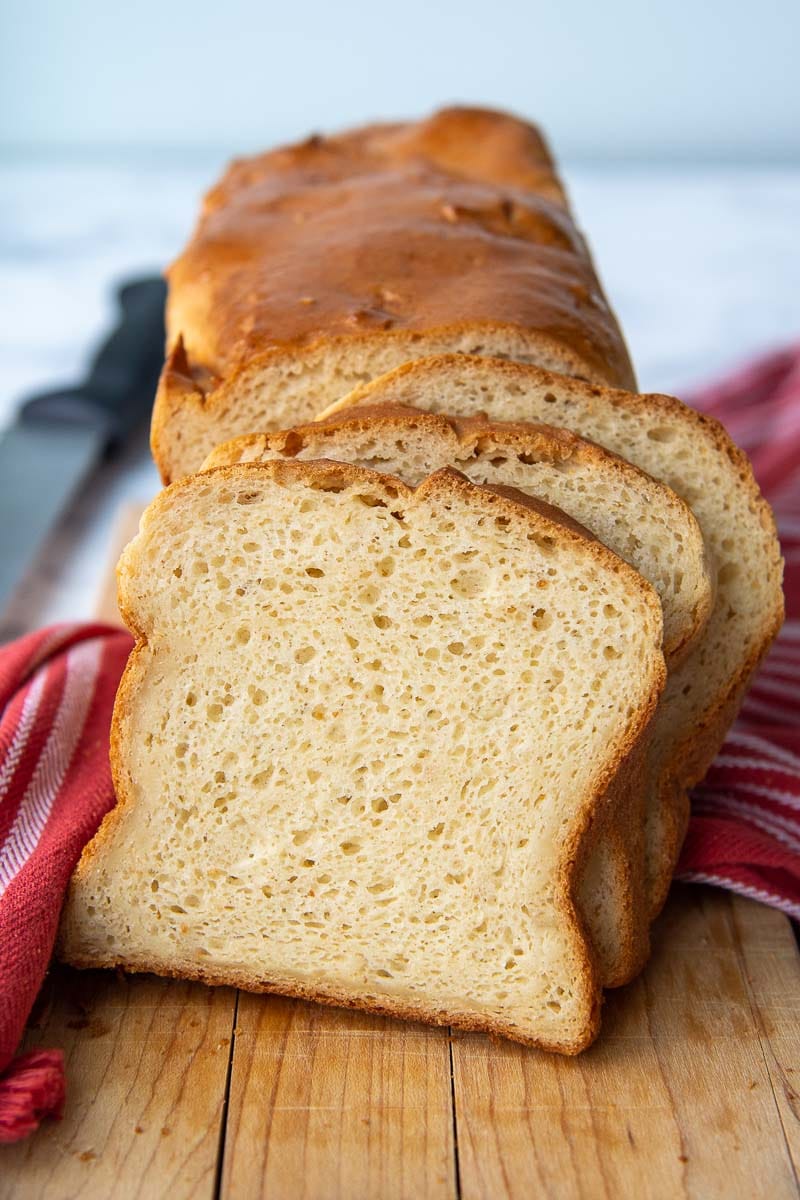
Best recipe for gluten-free bread
It has taken me years to fully stand behind a gluten free sandwich bread recipe. Every homemade recipe I tried was difficult, time consuming, and yielded the most disappointing results.
For the longest time, buying expensive, subpar store-bought gf bread sufficed because at least I was saving time!
So many readers, though, have asked for a great-tasting gluten free bread. Just like in my gluten-free rolls recipe and gluten-free biscuits, there have been a lot of trials, but I finally landed on a recipe that exceeds my essential criteria.
- Easy to make! It mixes together in one bowl, has one short rise, and bake.
- Simple ingredients I have stocked and ready at all times
- Quick and effortless – No one wants to spend all day making a loaf of bread.
- Most important – Tastes BETTER than any gluten free bread out there. Seriously.
I wouldn’t stand behind this recipe if I didn’t feel it 100% met all these crucial elements. I know what it feels like to waste precious time and expensive ingredients, and I wasn’t about to add another recipe to that vortex!
I truly hope this recipe makes all your gluten free dreams come true, just as much as it has for me! Read the comments below to see how this magical bread recipe has transformed many readers’ lives, then check out many more highly-reviewed gluten-free bread recipes!
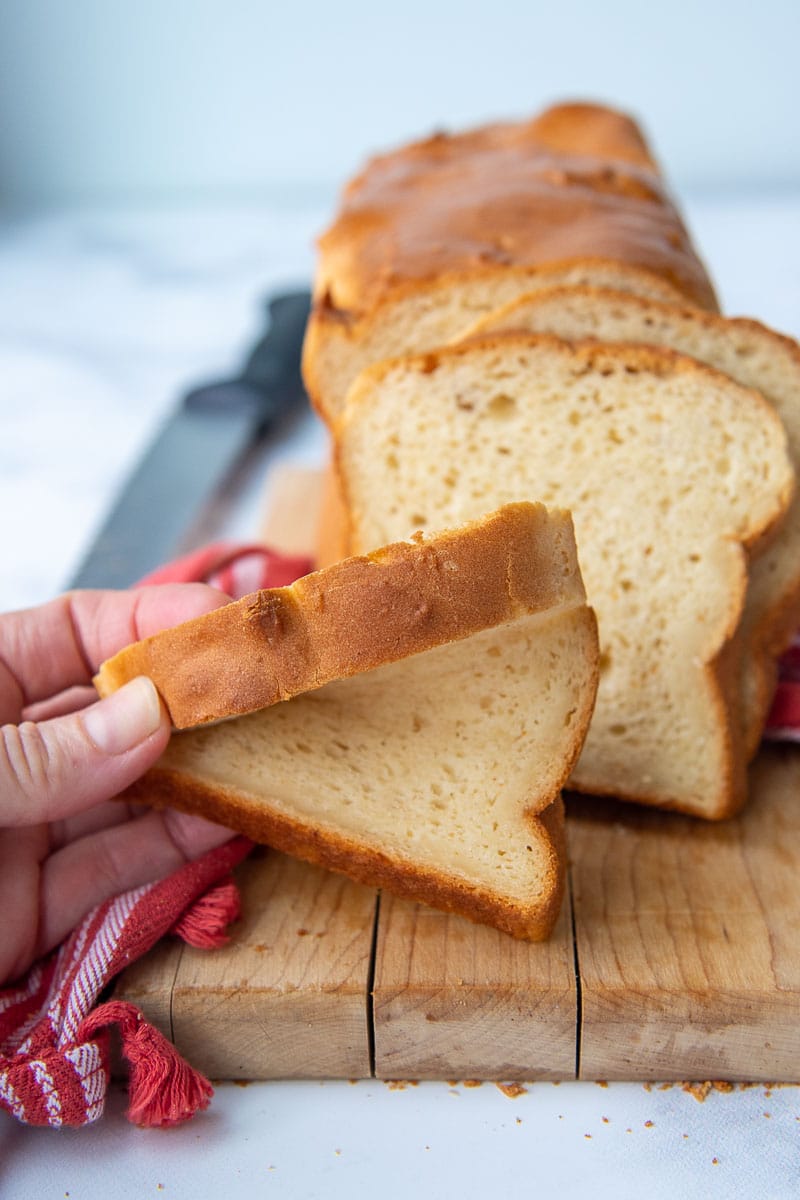
Ingredients Needed
Since sandwich bread is an everyday staple, the ingredients should be simple, affordable, and ready to go whenever. This recipe also works perfectly for gluten-free stuffing or gluten-free bread crumbs.
Many readers love this homemade bread recipe so much, they ask if they can shape it into other types of breads. The GF bread category on the site includes many adaptations, including homemade gluten-free hot dog buns, rolls, and more!
- Gluten-free flour – Using a good gluten free flour (I highly recommend Cup4Cup GF flour) makes or breaks the quality of the bread. I tested the recipe with different flours to make sure it consistently turns out, but some performed handedly better than others. See below for what to use and avoid.
- Psyllium Husk Powder – I’ve made the bread multiples with and without the psyllium husk powder. It doesn’t affect the taste, but it does help maintain moisture and prevents the bread from becoming crumbly. Learn more about the benefits of psyllium in gluten-free breads here!
- Baking powder
- Salt
- Instant (Rapid Rise) Yeast – I would suggest buying this is bulk and storing in your refrigerator.
- Honey – Granulated sugar may be substituted
- Eggs
- Oil – Or substitute the same amount of melted butter, but not for gluten-free dairy-free bread.
How to make gluten-free bread
(Below shows step-by-step photos and modified instructions. For the complete recipe, along with ingredient amounts, scroll down to the recipe card.)
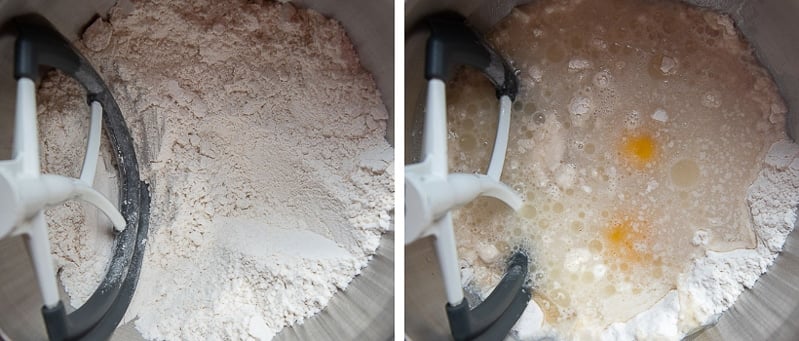
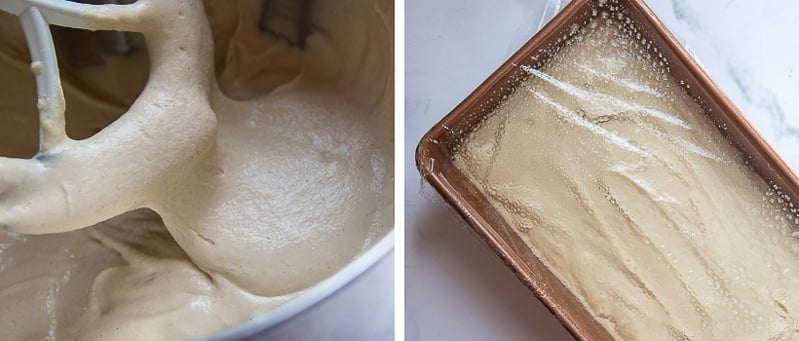
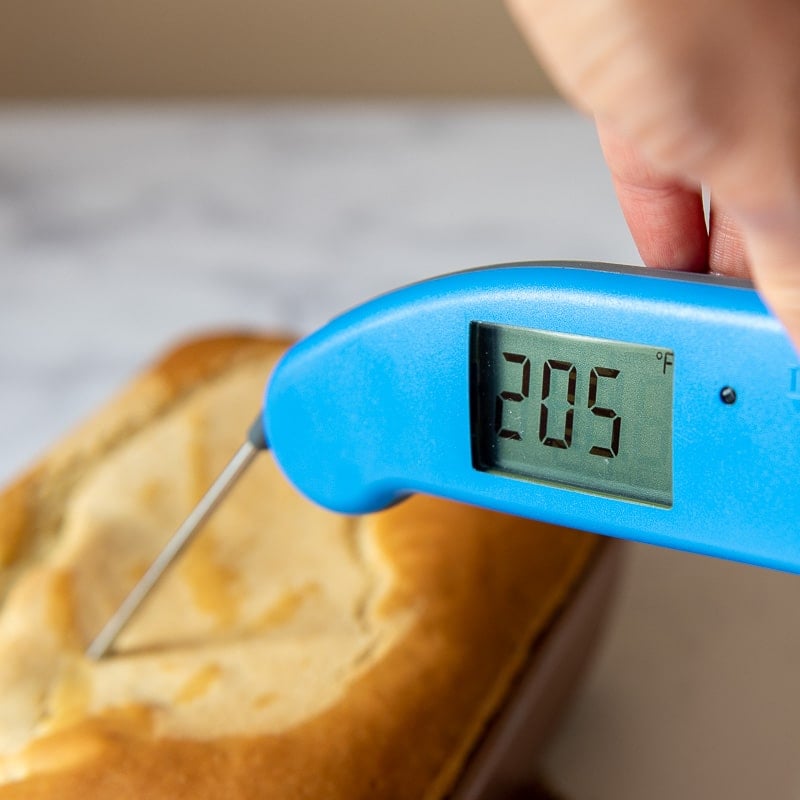
- First combine the dry ingredients in a bowl of a stand mixer. Use the paddle attachment to combine on low speed.
- Add the liquid ingredients – warm water, eggs, honey, and oil. Mix on low to combine for 1 minute.
- Increase speed to medium and beat for 5 minutes. This gives time to hydrate and relax the starches so your bread is soft instead of gritty.
- Scrape the dough into a greased bread pan. Spray a large piece of plastic wrap with nonstick spray and lay over the top of the pan. Set the pan in a warm place while the oven preheats to 350ºF, about 30-45 minutes. The bread should rise almost the top of the pan.
- Bake bread for 40-45 minutes, tenting a piece of foil loosely over the bread for the last 20 minutes. or until the internal temperature reaches 205ºF.
Best Gluten-Free Flour to use for bread
Once the recipe was perfected, it was tested with three different gluten free flours to make sure the results were consistent.
Using information from the best gluten free flour article, I eliminated using Bob’s Red Mill 1-to-1 GF Flour because it had such disappointing results across the board.
I tested with Cup4Cup, which rates as the top gluten free flour, King Arthur Measure-for-Measure, and Pillsbury gluten free flour because some readers have been asking about its performance.
From an ease and baking standpoint, they all performed well. Pillsbury had the most solid structure, which turned out to be a not very good thing. Cup 4 Cup was the softest, with King Arthur in between.
As far as taste, Cup 4 Cup was the clear winner. There was nothing “gluten free” tasting about the bread. It was soft, squishy, and slightly sweet.
(By the way, Cup4Cup also handedly won out in the best all purpose flour for gluten free banana bread as well.)
King Arthur still tasted good and had a favorable texture, but had a strong rustic taste to it. It reminded me more of wheat bread than white bread.
Sadly the bread made with GF Pillsbury flour went straight into the trash. It tasted like dry cardboard and was inedible. Pillsbury gluten free flour might work for other recipes, but definitely did not work well with this one!
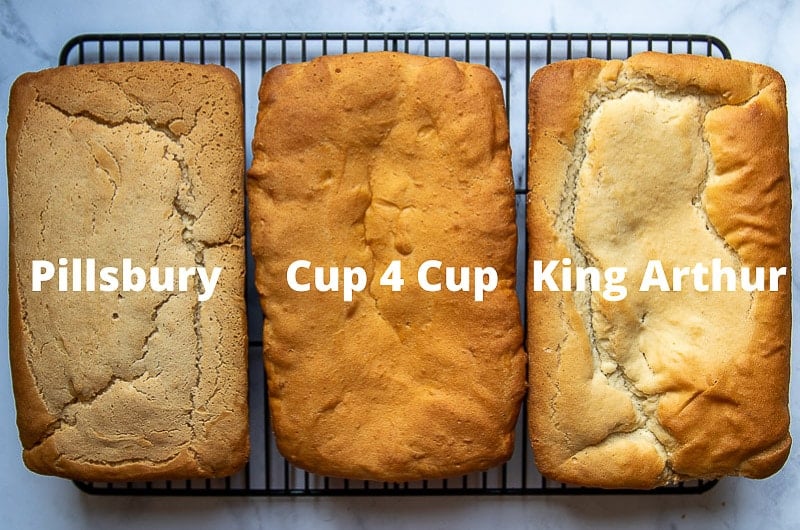
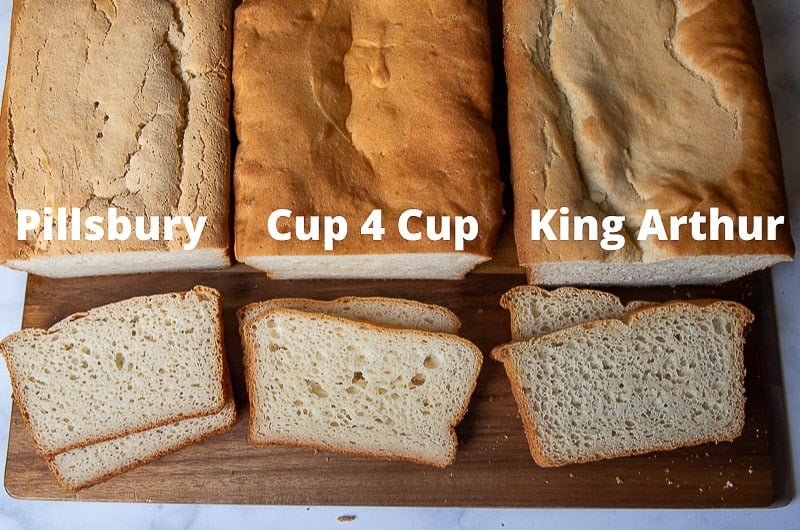
best yeast to use
Instant Rapid Rise yeast, either Red Star or Fleishman’s brand is best. Instant yeast has smaller granules so it does not have to be proofed before using. Just be sure your water is warm enough to activate the yeast while mixing.
If you only have active dry yeast on hand, that will work as well. Simply add the yeast to the warm water with 1 teaspoon of sugar. Stir and let it sit for 5 minutes. Once it’s foamy, add to the dry ingredients with the eggs, honey and oil.
how to know when gluten-free bread is done
I highly recommend using an instant read thermometer to check the temperature when baking gluten free. Typically, the bread will “look” done before it’s actually done adequately baking.
If you pull the bread too soon the liquids won’t have time to evaporate and it will be gummy and dense, instead of soft and fluffy.
The internal temperature should reach 205ºF. Checking quickly with an instant read thermometer will help the bread retain valuable heat while the temp is being read. A Thermoworks Thermapen does this efficiently and accurately.
storing and freezing
Gluten-free bread does not have the shelf life like normal bread. Refrigerating will dry it out, and is not recommended. It may be wrapped tightly and left at room temperature, but will lose optimal taste and texture quickly.
For best results, slice and freeze the bread after it has completely cooled (at least 3 hours). Pull slices as needed from the freezer to defrost or toast from frozen.
important note about serving
Generally GF bread requires toasting or a buttered griddle to taste good, but not with the best gluten free bread recipe! Room temperature bread is soft, fluffy, and delicious tasting!
However, please note, if pulling from the freezer and serving at room temp, thoroughly defrost the bread first. If it is chilled slightly it will become more crumbly.
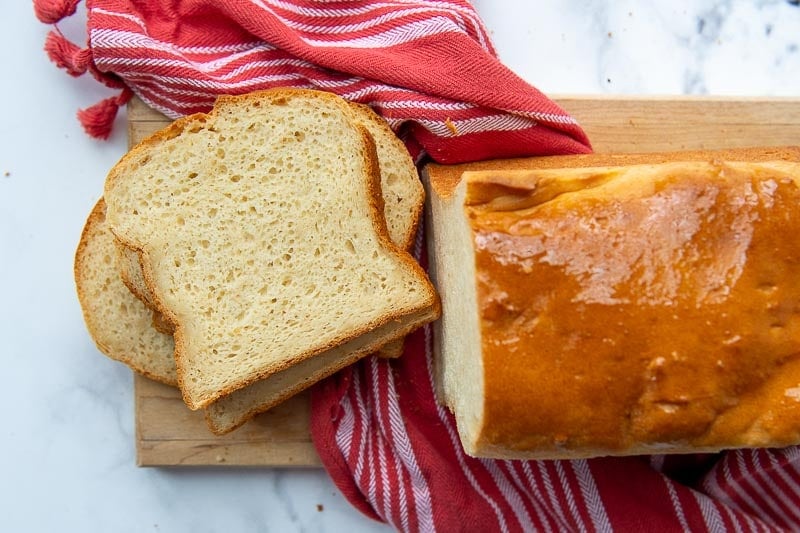
Dairy-free modification
All the ingredients in this gluten-free bread recipe are dairy-free. However, if you choose to use Cup4Cup brand flour, it does contain milk powder. If this doesn’t work for you, I recommend using King Arthur Measure-for-Measure instead.
How to make in a bread machine
Although I have not personally tried making this recipe in a bread machine, several readers have written in and said they’ve had great results using one!
You will need a bread machine with a gluten-free setting. Add all the wet ingredients to the bottom of the bread baking pan. Then add the dry ingredients over that. Start the bread machine and set it to the “gluten-free” setting.
Do I need a stand mixer?
Yes and no. It definitely makes the sandwich bread recipe easier to throw together. It may be done with a hand held mixer, but since it uses a large amount of flour, it will be a lot more taxing on the mixer and yourself.
If you don’t want to invest in a stand mixer (although don’t get me started on how obsessed I am with mine!), a gluten-free bread machine would be a cheaper option and just as easy!
Do I Have to add psyllium husk?
No. I’ve made the bread multiples with and without the psyllium husk powder. It doesn’t affect the taste, but it does help maintain moisture, prevents the bread from becoming crumbly, and makes it softer.
Psyllium husk powder is very affordable to buy, lasts a long time, and greatly improves GF breads texture because it helps absorb moisture. It also works well for gluten-free pizza dough and gluten-free cinnamon rolls.
I recommend this brand because the lighter color doesn’t affect the bread. Some powders are darker, which will make GF baked goods a grayish, purple color.
Best Baking Pan to Use
Use a 9X5 or 9X4 loaf pan. A small pullman pan makes bread with the most authentic sandwich bread shape for slicing and conducts heat evenly while baking.

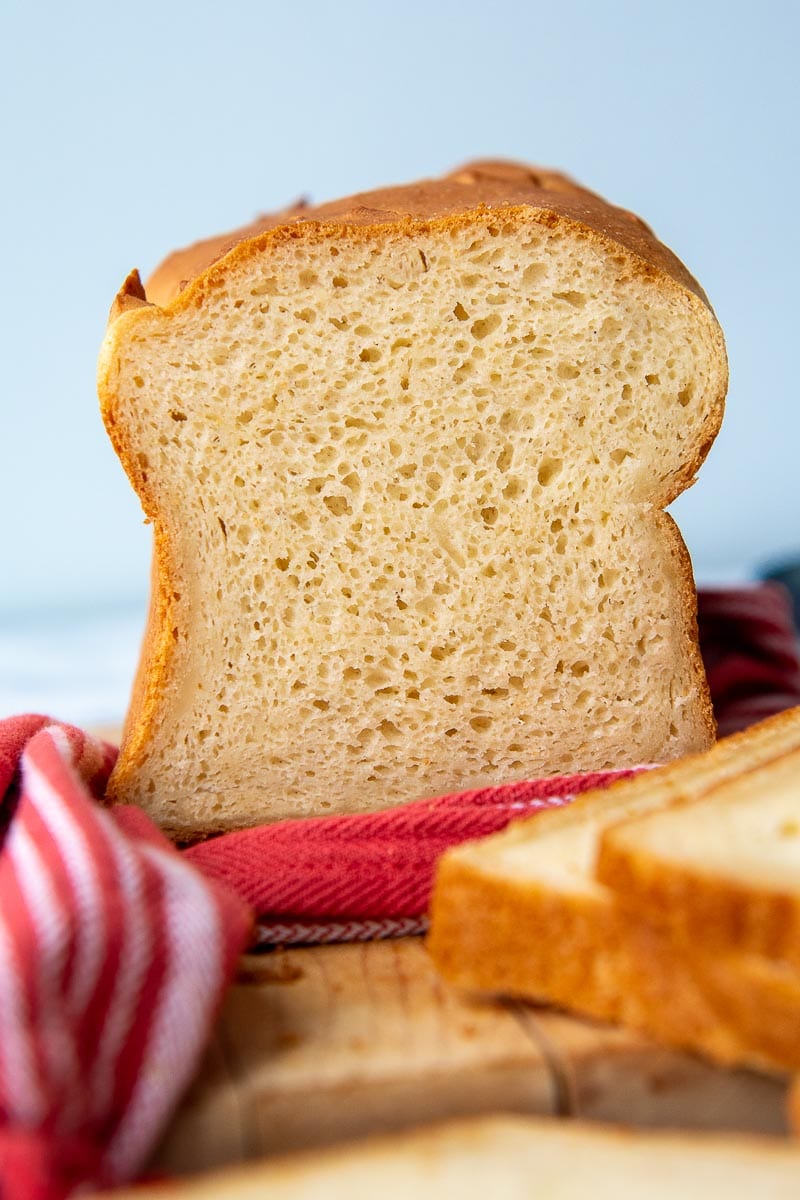
SAVE THIS RECIPE FOR GLUTEN-FREE SANDWICH BREAD TO YOUR PINTEREST BOARD!
Let’s be friends on Pinterest! I’m always sharing great recipes!
How to Make Ultra Soft White Gluten Free Bread
Listen to Recipe Audio
Equipment Needed
Ingredients
- 3 cups (438g) gluten free all purpose flour (Cup4Cup gluten free flour highly recommended – see recipe notes for DF)
- 1 packet (2 ¼ tsp, 9g) instant rapid rise yeast
- 1 tablespoon (11g) psyllium husk powder (optional) helps with bread moisture & structure (what is psyllium husk?)
- 1 teaspoon baking powder
- 1 teaspoon salt
- 1 ½ cups (360g) warm water (110°F)
- 2 eggs room temperature
- ¼ cup (85g) honey
- ¼ cup (55g) vegetable oil
Instructions
- Using a stand mixer with paddle attachment, mix together gluten free flour, yeast, optional psyllium husk powder, baking powder, and salt on low speed until combined.3 cups (438g) gluten free all purpose flour,1 packet (2 ¼ tsp, 9g) instant rapid rise yeast,1 tablespoon (11g) psyllium husk powder (optional),1 teaspoon baking powder,1 teaspoon salt
- Add warm water, eggs, honey, and vegetable oil. Mix on low speed to let the dough come together, about 1 minute.1 ½ cups (360g) warm water (110°F),2 eggs,¼ cup (85g) honey,¼ cup (55g) vegetable oil
- Increase speed to medium and beat for 5 minutes, scraping down paddle and bowl halfway through. The batter will be thinner, slightly thicker than cake batter.
- Grease a 9X5 or 9X4 baking pan. Pour into the pan and smooth top evenly with a spatula. Spray a large piece of plastic wrap with nonstick cooking spray. Lay the plastic, greased side down, over the pan.
- Set in a warm, draft-free place to rise until the bread reaches two-thirds to the top of the pan (do not let it go over this point because it rises more in the oven). This should take about 30-45 minutes. Meanwhile preheat oven to 350°F.
- Remove plastic and bake bread on middle rack for 40-45 minutes, tenting a piece of foil loosely over the bread halfway through. The internal temperature of the bread should read 190-200°F.
- Allow the loaf to cool for 5 minutes in the pan and then remove to a cooling rack. Allow bread to cool completely, at least 2-3 hours, before slicing. For best results, serve the bread at room temperature, toasted, or grilled. Chilled, cold bread has an adverse effect on texture.
- DID YOU MAKE THIS RECIPE?? DON'T FORGET TO LEAVE FEEDBACK AND RATE BELOW!
Recipe Notes
Dairy Free Modification
All the ingredients in this gluten-free bread recipe are dairy-free. However, if you choose to use Cup4Cup brand flour, it does contain milk powder. If this doesn’t work for you, I recommend using King Arthur Measure-for-Measure instead.Psyllium Husk Powder
I’ve made the bread multiples with and without the psyllium husk powder. It doesn’t affect the taste, but it does help maintain moisture, prevents the bread from becoming crumbly, and makes it softer. Psyllium husk powder is very affordable to buy, lasts a long time, and greatly improves GF breads texture because it helps absorb moisture. I recommend the psyllium listed in the ingredients because the lighter color doesn’t affect the bread. Some powders are darker, which will make GF baked goods a grayish, purple color.How to Make in a Bread Machine
Although I have not personally tried making this recipe in a bread machine, several readers have written in and said they’ve had great results using one! You will need a bread machine with a gluten-free setting. Add all the wet ingredients to the bottom of the bread baking pan. Then add the dry ingredients over that. Start the bread machine and set it to the “gluten-free” setting.How to Know When Bread Is Done
I highly recommend using an instant read thermometer to check the temperature when baking gluten free. Typically, the bread will “look” done before it’s actually done adequately baking. If you pull the bread too soon the liquids won’t have time to evaporate and it will be gummy and dense, instead of soft and fluffy. The internal temperature should reach 190-205ºF. Checking quickly with an instant read thermometer will help the bread retain valuable heat while the temp is being read. A Thermoworks Thermapen does this efficiently and accurately.Freezing / Storing
Gluten-free bread does not have the shelf life like normal bread. Refrigerating will dry it out, and is not recommended. It may be wrapped tightly and left at room temperature, but will lose optimal taste and texture quickly. For best results, slice and freeze the bread after it has completely cooled (at least 3 hours). Pull slices as needed from the freezer to defrost or toast from frozen. Generally GF bread requires toasting or a buttered griddle to taste good, but not with the best gluten free bread recipe! Room temperature bread is soft, fluffy, and delicious tasting! However, please note, if pulling from the freezer and serving at room temp, thoroughly defrost the bread first. If it is chilled slightly it will become more crumbly.Nutrition
This post contains affiliate links. My opinions are always my own. If you purchase a product through an affiliate link, I make a small commission – at no cost to you. Read full disclosure policy here.

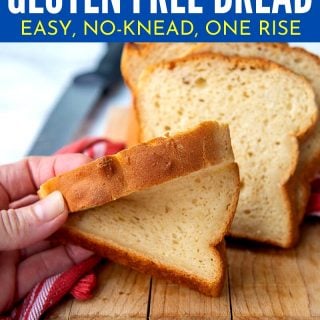
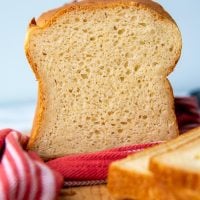
Maria says
Soooo grateful I found this recipe. Loved the exact measurements. Used King Arthur’s gluten free bread flour, and even at high altitude this recipe turned out perfect. So much better than store bought gf breads, thank you!
Amy Ingersoll says
Thank you so much for this recipe! I would like to replace the vegetable oil with butter. Is there a reason it may not work?
Melissa Erdelac says
No, that should be fine. Just use melted butter. Enjoy!
Best,
Melissa
Jenna says
Have you ever tried the cup-4-cup wholesome flour instead??
Melissa Erdelac says
Hi Jenna,
I haven’t, but I get loads of comments from reader’s using different GF flours and it seems to be pretty forgiving to all kinds. So I don’t see that being a problem!
Best,
Melissa
Rina says
Hello. Yesterday I’ve made this bread, for the first time using GF flours. It came perfect and taste delicious. Thanks for your hard work. I’ll keep trying other GF recipes.🤗🤗
Melissa Erdelac says
This makes me very happy, Rina. Please write back when you do! I love hearing from all of you.
Best,
Melissa
Gigi says
I’m fairly new to GF baking, and this was a wonderful and easy recipe to start with! The bread turned out amazing. I couldn’t wait and sliced off a small end piece while it was hot—with a tad of butter—and it was amazing!! (I didn’t have psyllium husks but substituted xanthan gum and it worked!) Thanks!
Melissa Erdelac says
Thank you for taking the time to share, Gigi! That’s helpful to know that xanthan works too. How much did you use?
Best,
Melissa
Gigi says
I used a tablespoon, since the psyllium husk was a tablespoon. I don’t know if that’s a normal substitution amount, but we liked the result! 🙂 I’ll try it with the psyllium next time—I was just cozy at home and didn’t want to venture to the store. 🙂
Cebrina Martin says
This bread is the best gluten-free bread I have had, truly better than store-bought. Even my non-gluten-free eating family loves it and they usually can’t stand eating gluten-free, which says a lot.
Melissa Erdelac says
Wow, that’s quite a compliment! And I agree, store-bought GF bread is a disappointment 🙁
Best,
Melissa
Karen says
Trying this in my bread machine now. Smells amazing. Can’t wait to taste it! Thanks for sharing the recipe.
Melissa Erdelac says
You’re so welcome, Karen! Enjoy!
Best,
Melissa
Lauren says
This is the first gluten free bread recipe I’ve tried and been happy with the results! So happy I found it! Thank you!
Melissa Erdelac says
I appreciate this, Lauren! Thanks for taking the time to let me know!
Best,
Melissa
Heather S says
This recipe makes the most beautiful bread. I used Anita’s Organic Mill GF Flour, topped with a bit of psyllium husk and oats, baked in a Pullman loaf tin. The result is beautiful to look at and delicious, with a soft, airy texture. It was very easy to make. Many thanks for sharing this wonderful recipe!
Melissa Erdelac says
Thank you, Heather! I appreciate you sharing your adaptations. So helpful for others!
Best,
Melissa
Andrea says
I make this once a week and it’s so good. It goes so fast. It’s so nice to have normal sized sandwich bread again!
Melissa Erdelac says
Thank you, Andrea! It’s so nice to not have to buy that awful bread, right??
Best,
Melissa
Melanie says
I’m not sure what went wrong. I made this twice and both times the consistency was like glue. There was no pouring out into pan. I had to scrape it out of the bowl. It didn’t rise. The second time I put it in a warm oven and forced it to rise. I cooked it anyway and it was small and “gummy tasting” per my celiac child. I read the comments to find tips, but didn’t see anyone with this problem. I really want a successful bread I can make for my child. I used all the same items mentioned or linked, except I used Red Star Quick Rise Instant Yeast (in date) instead of saf-instant. I’m hoping that’s the problem. I also used EVOO instead of veg oil. Please help!
Melissa Erdelac says
Oh Melanie, I’m so sorry this happened! The modifications you did make would not have made a difference like this. If you used Cup4Cup flour the batter should look exactly like the picture. You’re absolutely certain the flour and liquids were correct? The fact that you have made this twice and it happened both times, though, makes me think something else is happening. How were you mixing the batter? Hand mixer or stand mixer with paddle attachment?
Best,
Melissa
Barb says
I too am having issues. I’ve made it twice, one in the regular oven and the second time in convection mode and even left it in longer. The temperature was right and the bottom looked nicely baked but after it cooled and I cut it, the bottom was raw, both times. And as much as I want a nice soft bread, it was a little too moist. How can I fix this as, let’s face it, gluten free flour is quite expensive. Thanks!
Melissa Erdelac says
Oh, I hear you, Barb. Gluten-free flour is hard to waste! Which flour are you using? I find some require less liquid. I would try cutting back the water by 1/4 cup. Also, are you using the psyllium? That helps absorb the liquids. If I have a problem with gumminess in other bread recipes I create, I find replacing about 1/3 cup of GF flour with potato starch does a nice job of absorbing and softens the texture as well.
Best,
Melissa
BARB says
I used Bob’s Red Mill 1 to 1 Baking Flour. Yes, I used psyllium as well.
Melissa Erdelac says
Hi Barb,
Huh, well that’s good you are using the psyllium. Since you are using Bob’s I would try cutting back on the water by 1/4 cup and replacing 1/2 cup of the flour with cornstarch and see if that helps.
Best,
Melissa
Barb says
Thanks, I’ll try that!
Liza says
Tried this today and although it was the best tasting gf bread ever, it deflated on me a few minutes out of the oven. Not sure what I did wrong. I will try again, it tasted that good,.
Melissa Erdelac says
Hi Liza,
What GF flour did you use? It sounds like you need to cut back on the liquids a tad (like 3-4 tbsp), let it bake a little longer, and lay it on its side as it cools. Your oven may be running a tad too hot, which would activate the baking powder too quickly and then the bread would deflate. Sorry, I’m throwing a lot at you! I just want to make sure you get the best results next time!
Best,
Melissa
Stacey Carroll-Kennard says
⭐️⭐️⭐️⭐️⭐️ My child has celiac disease and has tried many breads, both store bought and homemade. They said that this is not only their favorite gluten free bread they’ve ever tried, but it is their favorite loaf bread of all time (gluten included). They said it tastes like rolls and nearly cried when they were able to make a yummy peanut butter sandwich for the first time in years. Thank you so so much for bringing this recipe to us!! Psyllium husk will be an on hand staple in our house from now on.
Melissa Erdelac says
Stacey,
This made me nearly cry! You have no idea how much joy this brings me. Thank you for taking the time to let me know. It is immensely appreciated 🙂
Best,
Melissa
Stacy says
This bread is FANTASTIC! It’s the first recipe of GF bread that I’ve made that actually looks like regular homemade bread and tastes like it and I was delighted! I have been baking GF for 5 years (had to be yeast and egg free for a while) and this is the best bread I’ve made in that time. Thank you SOOOO much!
By the way, your exact measurements were very helpful since I was using a different flour blend. I used Sarah Bakes GF Flour blend and it worked beautifully.
Melissa Erdelac says
Thank you so much, Stacy! Every time I hear this I know EXACTLY how the person feels. Before creating this recipe, I have been disappointed by bread for WAY TOO LONG. We deserve this!
Best,
Melissa
Valerie Johnson says
Finally. I finally found a really good GF bread recipe. It is excellent. Sharing with two family members that are GF. Made it exactly as recipe stated. Super easy and very fast. Im definitely going to try the pizza crust. Thank you so much!
Melissa Erdelac says
Yes, please do, Valerie! I’m in love with the pizza crust! I wish restaurants would serve it…
Best,
Melissa
Ellie says
I made this last night and it was awesome!! I was surprised at how simple the recipe is and how great it tastes! Definitely a win for me!!!
Melissa Erdelac says
So happy to hear, Ellie! Thanks for sharing!
Best,
Melissa
Dawn Parks says
Making this recipe for the second time. I have finally found a wonderful soft gluten free loaf bread! I have shared the link with friends! Thank you!!!
Dawn
Melissa Erdelac says
Yay! Thank you so much for sharing, Dawn! It really helps!
Best,
Melissa
Vijeyta says
Can we make this gf bread without eggs??
Melissa Erdelac says
Hello,
I haven’t personally tried this, but I do remember people writing in and saying that egg replacers work well with it!
Best,
Melissa
Kim says
I absolutely love this bread just made my second loaf definitely our go too bread recipe
Melissa Erdelac says
Love hearing this, Kim!
Best,
Melissa